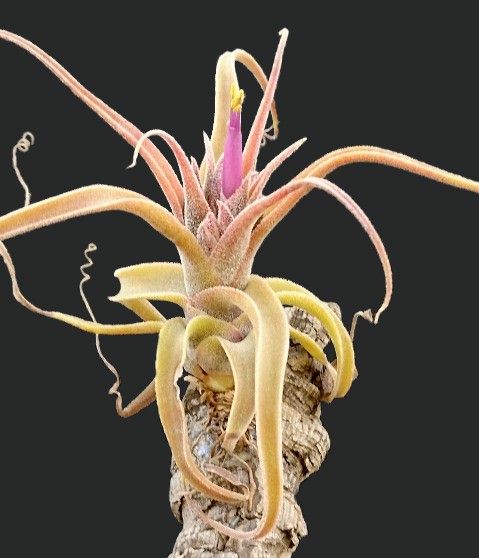
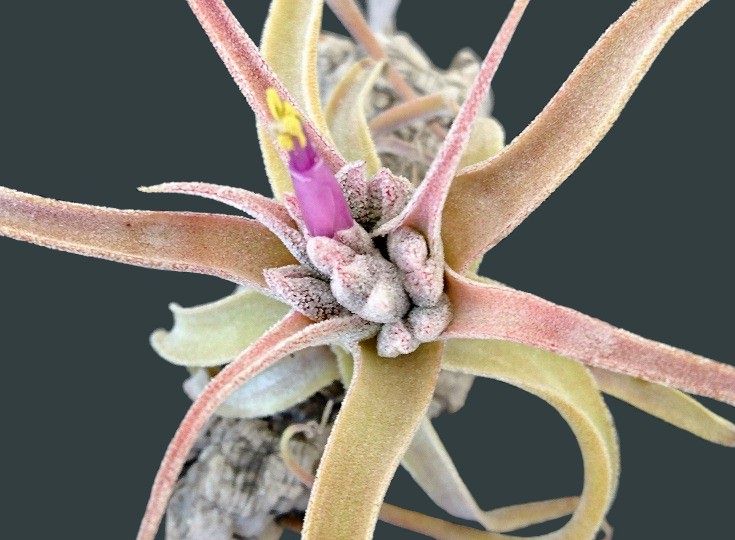

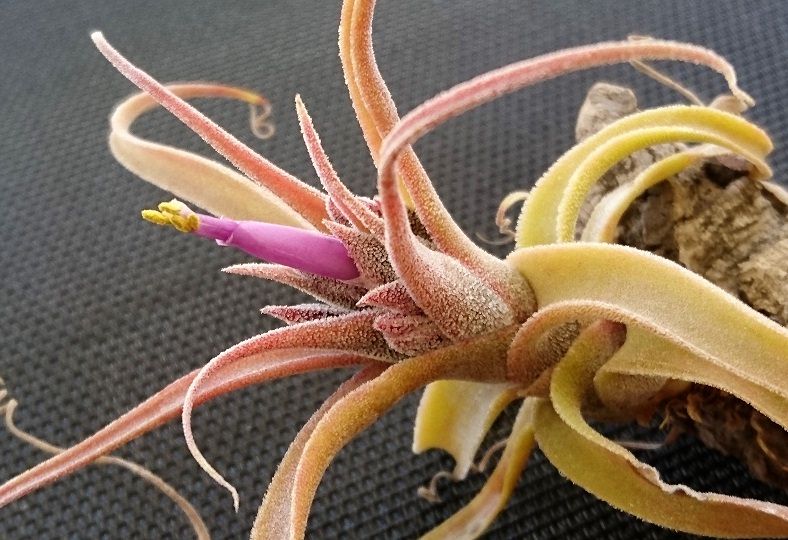
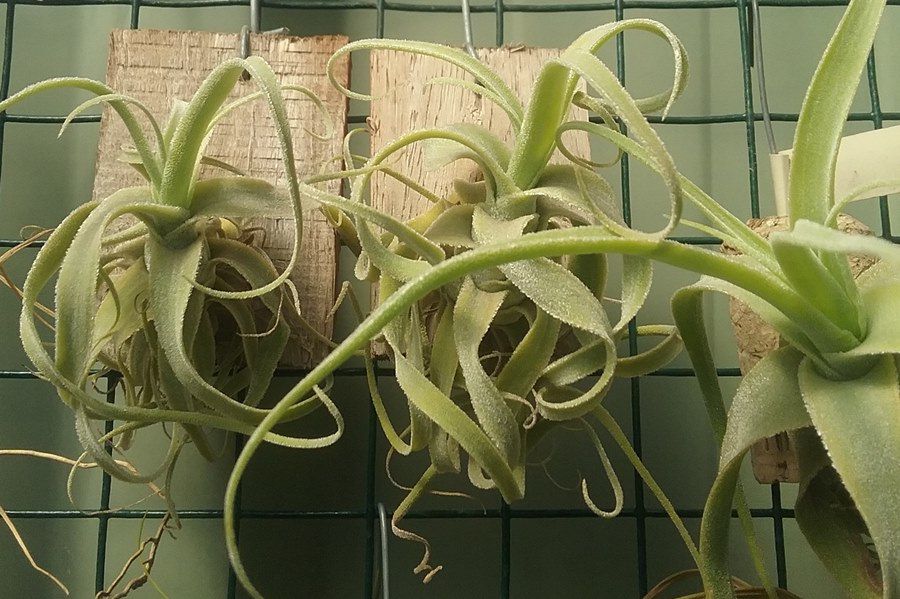
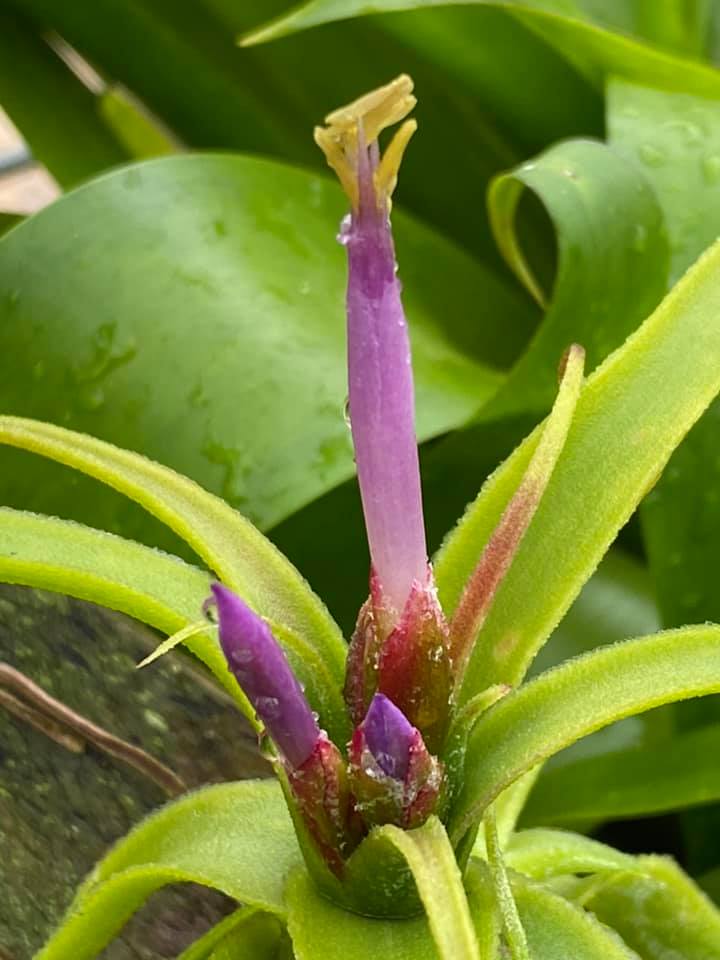
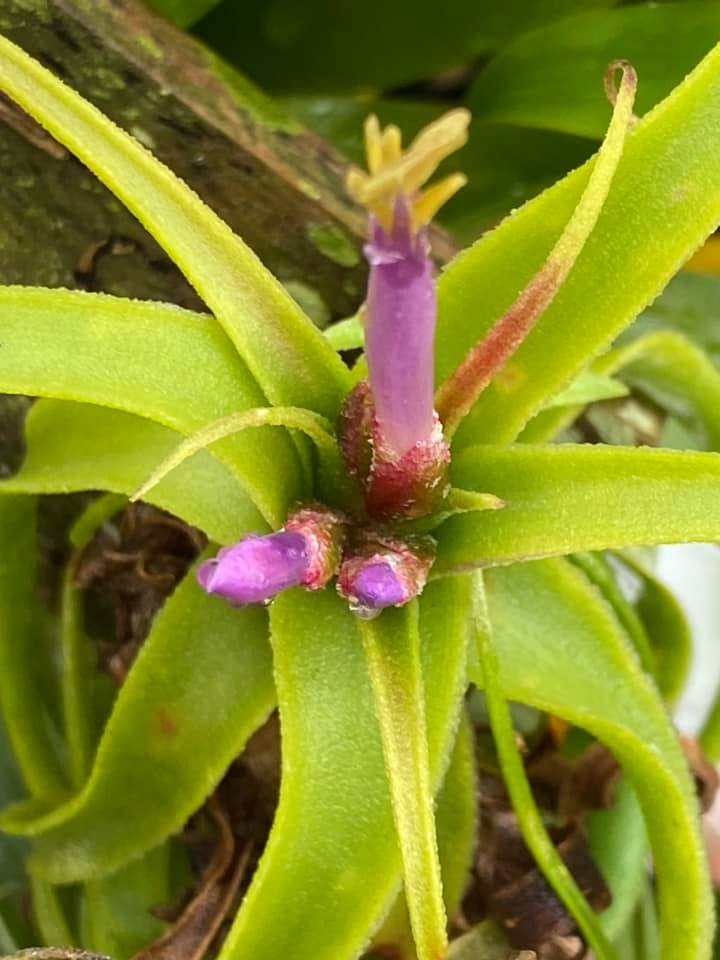
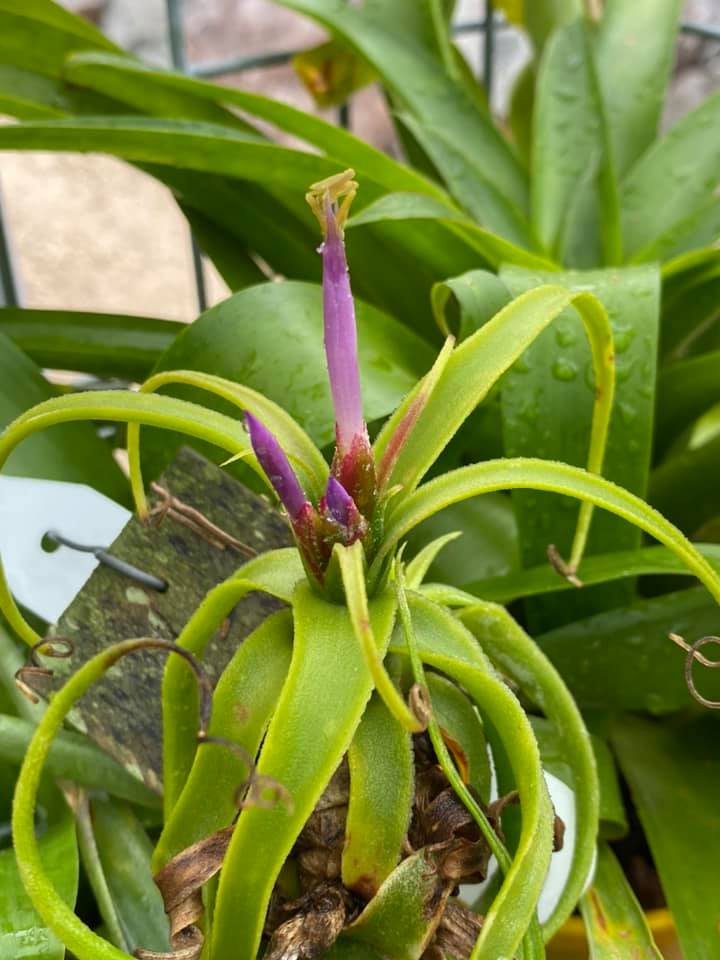
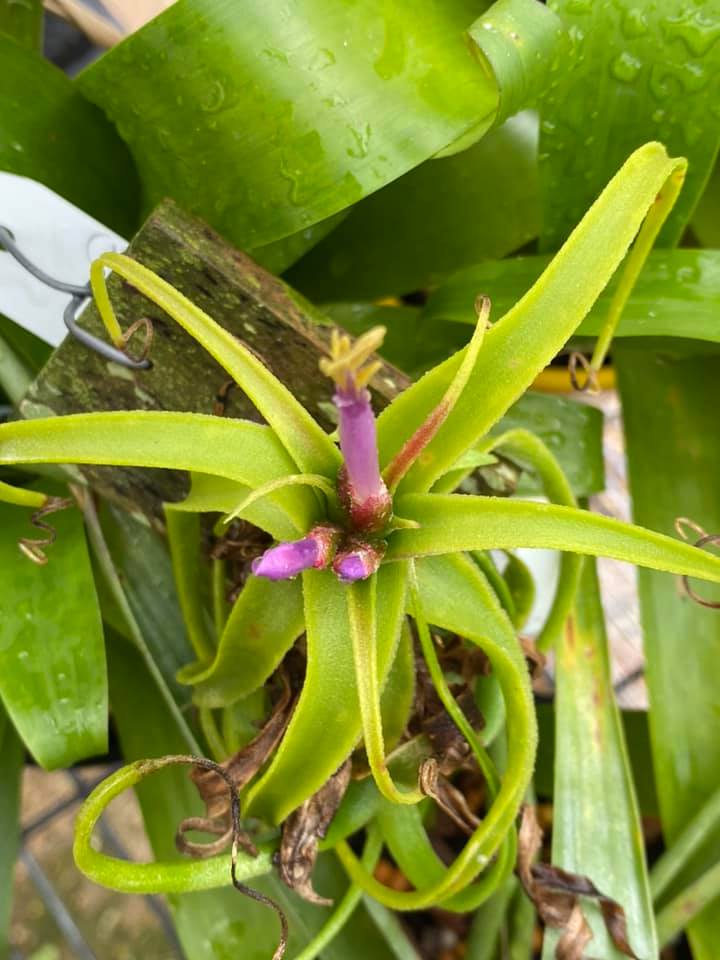
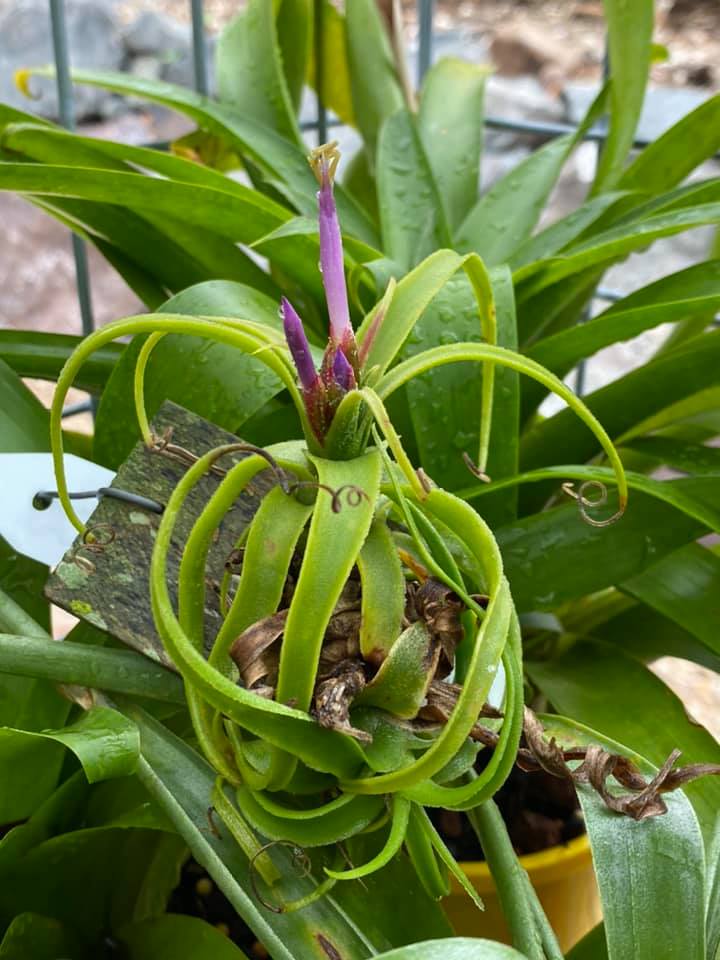
Tillandsia diguetii Mez et Roland-Gosselin (1919) by WERNER RAUH in J. Brom. Soc. 32: 95. 1982
In the Journal of the Bromeliad Society Vol. XXXI, Nr. 5, on page 218, one of my photographs was reproduced as Tillandsia diguetii. The plant in the photograph however, is not T. diguetii, but represents a new species, which I had received originally under the name T. diguetii from Dr. Jorg Rutschmann of Basel, Switzerland. The plant has a rosette about 20 cm high, the leaves are strict erect and the inflorescence is deeply sunken into the center of the rosette, much exceeded by the blades.(Described as T. nidus) T. diguetii, known only from the type locality of Manzanilla, Colima, Mexico, was re-collected by Renate Ehlers of Stuttgart, Germany, and I am very obliged to her for the flowering specimen that she gave me so that we are now able to show the real T. diguetii which in the vegetative state resembles a dwarf form of T. streptophylla.
T. diguetii is a stemless plant, only 7-8 cm high; leaves many; sheaths inflated, forming an ellipsoid pseudobulb of 2-2.5 cm in diameter; blades recurved, about 10 cm long, 1 cm wide at the base, attenuate, flat, recurved, and often contorted, densely and coarsely covered by whitish-gray, subspreading trichomes. Scape lacking; inflorescence sessile in the center of the leaf-rosette, compound, bipinnate, with about 5 spikes, densely capitate; primary bracts subfoliate, much exceeding the spikes, but exposing them because of the reflexed blades. The spikes are strict, sessile, elliptic-acute, 3 cm long, 1 cm wide, densely 2-3 flowered; floral bracts about 2 cm long, exceeding the sepals, imbricate, carinate, slightly incurved towards the apex, lepidote; sepals obtuse, coriaceous, membranaceous at the apex, lepidote; the posterior ones carinate and connate for 3-4 mm; petals 22-25 mm long, blue-violet.
The plant is cultivated in the Heidelberg Botanical Garden under the number B G H 55202. The plant must be determined with the help of Subkey VII in the "Tillandsioideae" by L. B. Smith in Flora Neotropica, Nr. 14, part 2.
From McVaugh in Flora Novo Galiciana 1989
Tillandsia diguetii Mez & Rol.-Goss. ex Mez, Repert. Sp. Nov. 14: 250. 1916.
On trees in lowland deciduous or subdeciduous forest or thorn forest, near the Pacific Ocean, 400 m or less, flowering, in May, collected in fruit in December and March.
Jal., Col. (Manzanillo, Diguet, the type from a cultivated plant, the holotype originally at B; B photo 1191/2!). Endemic as far as known.
Ca 7-8 km E of Chamela, grounds of the Estacion de Biologia, 30 m (McVaugh 25214, in part, MICH, det. J. Utley); also cited by Magana from localities near the above, the specimens all from MEXU: 47 km N of the Estacion de Biologia (Magana et al. 230); near the Estacion de Biologia (Magana & Lott S, 16, 28, 29, 210, 223); 28 km from Cutzmala, road to Playa Teopa (Magana et al. 225); "17 km E
i.e., ± NNE, road to Minatitlan
of Manzanillo, Hwy 98" (Gardner 1530! in 1981); km 18 between Colima and Manzanillo, 400 m, forest on calcareous soils (Valenzuela Z. 107, IBUG).
Acaulescent;
leaves 14-20 or more, green, the inner ones reddish at flowering time;
sheaths curved, ovate to suborbicular, 1.5-2.5 cm long, forming a pseudobulb 2.5-5 cm long, prominently veined;
blades triangular-attenuate, densely cinereous lepidote, recurved and contorted, 4-12 cm long, 3-10 mm wide;
inflorescence nearly sessile in the center of the rosette (the peduncle up to ca 1 cm long), compound, capitate, of 1-5 nearly sessile 2- or 3-flowered spikes 2-3 cm long;
primary bracts foliaceous, up to 10 cm long, 8-10 mm wide, much surpassing the axillary spikes but exposing them because of the reflexed blades;
floral bracts 1.5-2 cm long, 6-10 mm wide, surpassing the sepals, coriaceous, sharply keeled, slightly nerved, lepidote;
sepals elliptic, subacute, coriaceous, 1.3-1.6 cm long, 3-6 mm wide, nerved, keeled, densely lepidote, green, the adaxial ("posterior") pair connate 3-4 mm;
petals purple, 2-3 cm long;
stamens exserted; stigma spiral;
fruit 3- 4.5 cm long, 7-8 mm thick;
seeds 50-60, 3 cm long. {Description partly adapted from Magana.}
Known to Smith from the type-locality only, this plant is apparently not uncommon in the lowlands from Manzanillo northwestward. In the vicinity of Chamela it grows with the very similar Tillandsia ionantha, with which it is easily confused. A collection that includes both species (McVaugh 25214, MICH) was cited in Flora Neotropica (Smith & Downs, 1977) under the name of T. pruinosa Sw., a species not otherwise reported from Mexico west of Oaxaca.